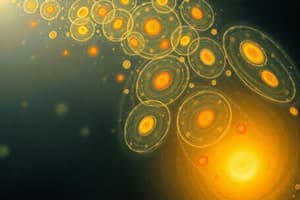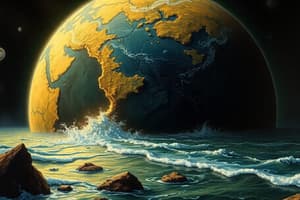Podcast
Questions and Answers
What is the period between 4.6 and 4 billion years ago on Earth known as?
What is the period between 4.6 and 4 billion years ago on Earth known as?
- Phanerozoic eon
- Proterozoic eon
- Archean eon
- Hadean eon (correct)
What is believed to have provided the necessary energy for the synthesis of organic compounds from inorganic ones on early Earth?
What is believed to have provided the necessary energy for the synthesis of organic compounds from inorganic ones on early Earth?
- A natural nuclear reactor (correct)
- Lightning strikes
- Solar radiation
- Volcanic activity
Which major element was not abundantly available on the early Earth's surface?
Which major element was not abundantly available on the early Earth's surface?
- Hydrogen
- Phosphorus (correct)
- Carbon
- Oxygen
What is the earliest estimated age of the first traces of life on Earth?
What is the earliest estimated age of the first traces of life on Earth?
What is the process by which the initial formation of the planet Earth occurred?
What is the process by which the initial formation of the planet Earth occurred?
What was the early Earth's surface primarily composed of?
What was the early Earth's surface primarily composed of?
What was the primary composition of the early Earth's atmosphere?
What was the primary composition of the early Earth's atmosphere?
What role did the early atmosphere play in the formation of complex organic molecules necessary for life?
What role did the early atmosphere play in the formation of complex organic molecules necessary for life?
What were the first life forms on Earth?
What were the first life forms on Earth?
What was the impact of cyanobacteria on the early Earth's atmosphere?
What was the impact of cyanobacteria on the early Earth's atmosphere?
Which of the following groups of organisms emerged after the Great Oxidation Event?
Which of the following groups of organisms emerged after the Great Oxidation Event?
What was the impact of the changing conditions on Earth during the Cambrian period?
What was the impact of the changing conditions on Earth during the Cambrian period?
Flashcards are hidden until you start studying
Study Notes
Early Earth and the Emergence of Life
Formation of Earth
The formation of Earth is a complex process that involves several stages. It begins with the accumulation of gas and dust particles under the influence of gravity, leading to the initial formation of the planet. Early Earth was a dynamic planet, experiencing bombardment from asteroids, and its surface was mostly composed of exposed rocks. The period between 4.6 and 4 billion years ago, known as the Hadean eon, is marked by a scarcity of records. The only surviving record from this era is found in a crystalline mineral called zircon. Despite the lack of information, scientists continue to study the few remaining records from this time, hoping to learn about the conditions under which life first emerged.
Origin of Life
The origin of life on Earth is believed to have occurred within 200 million years after the planet's formation. The first traces of life are estimated to be as old as 4.2 billion years, indicating that life began evolving soon after the Hadean eon. Prebiotic life requires a powerful energy source to initiate the synthesis of organic compounds from inorganic ones. A natural nuclear reactor provides the necessary energy, breaking down nitrogen, carbon dioxide, and water to create complex organic molecules. Additionally, life requires a steady supply of major elements such as carbon, hydrogen, oxygen, and nitrogen, which were abundantly available on the early Earth's surface.
Early Atmosphere
The early Earth's atmosphere was mostly composed of methane and carbon dioxide, with traces of ammonia and water vapor. These gases played a crucial role in the formation of complex organic molecules necessary for life's emergence. The atmosphere was not yet oxygen-rich but provided the essential elements required for the synthesis of biological compounds.
Evolution of Early Life
The first life forms were microscopic organisms known as cyanobacteria. These bacteria evolved around 2.4 billion years ago and became the first photo-synthesizers on Earth. Cyano-bacteria produced food using water and sunlight while releasing oxygen as a byproduct. This led to a sudden rise in atmospheric oxygen levels, creating an environment less hospitable for other anaerobic microbes. Evidence of this Great Oxidation Event can be found in changes in seafloor rocks.
The rise of oxygen also marked the emergence of multicellular life. Organisms such as priapulid worms, Wiwaxia, Anomalocaris, and even the 5-eyed Opabinia appeared during this time. Some of these groups, like the trilobites, were evolutionary experiments but eventually declined. The stromatolite-building bacteria also declined, and brachiopods became the dominant reef-builders. The conditions on Earth continued to change, leading to the emergence of most existing animal types by the end of the Cambrian period.
In conclusion, the formation of Earth is a complex process, with early life emerging within 200 million years after the planet's formation. The early atmosphere was primarily composed of methane and carbon dioxide, with traces of ammonia and water vapor, which were essential for the synthesis of organic compounds needed for life. The first life forms were microscopic organisms, followed by the emergence of multicellular life, culminating in the establishment of most existing animal types by the end of the Cambrian period.
Studying That Suits You
Use AI to generate personalized quizzes and flashcards to suit your learning preferences.





